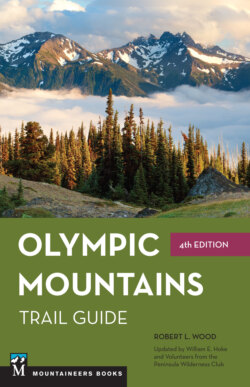Читать книгу Olympic Mountains Trail Guide - Robert Wood - Страница 25
На сайте Литреса книга снята с продажи.
CROSS-COUNTRY TRAVEL
ОглавлениеWhen hiking in the Olympics, one should stay on the trails whenever possible. At times, however, certain objectives can be reached only by traveling cross-country—picking out the best route possible, based upon one’s prior experience. This may be in deep forest, in canyons, across meadowland, or upon ridges, peaks, snowfields, or glaciers. On such occasions an ice ax is helpful, provided one knows how to use it. The hiker should also be prepared to travel in all kinds of weather.
The first explorers in the Olympics traveled cross-country because constructed trails were nonexistent. They quickly learned that the best way to traverse rugged terrain was to follow elk trails, and today’s hiker finds this still to be true. The conditions encountered in cross-country travel vary greatly, ranging from easy to difficult. At timberline it is often just a matter of walking across meadowland and through groves of subalpine trees. When attempting to reach a river below, it is usually better to follow down a spur ridge because the streams are likely to be in box canyons. On the ridges the ground is often open beneath the trees, although at lower elevations it is likely to be brushy.
One needs clear, sunny weather when traveling cross-country through rough terrain because route finding is all important. Often, it seems, the fog has a tendency to gather, obscuring the view, just when one needs to see the way ahead. The uncertainties of such travel sometimes make it necessary to bivouac. This can be disconcerting when one is on what was intended to be a day trip and is hiking without tent and sleeping bag. When an unexpected bivouac occurs at high elevation, the hiker is likely to face a long, cold night; if in a place where a campfire is permitted, one can keep reasonably warm but will have to sit around the fire all night. On the other hand, a scheduled bivouac is usually a pleasant experience. Perhaps one wishes to reach a certain destination—a peak or lake—without carrying a full pack, but the distance is too great for a one-day trek. On these occasions the hiker should take along a sleeping bag, ground cloth, bivvy sack, stove, and fuel, in addition to the Ten Essentials (see Before You Go).
